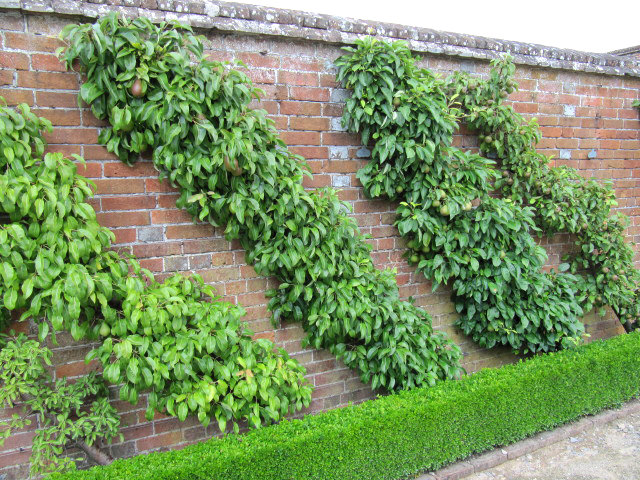
So even though I’m among the fortunate few who have a lot of space to grow fruit trees, I’m still fascinated by espaliered trees, those super-cool-looking, heavily pruned jobbies that you see in cool places like France, Italy or that one nursery that no one can afford. They’re pruned to grow flat against a wall or fence, saving garden space and looking snazzy. A win-win!
At this point, I have two very young trees that could be candidates for espalier: my precious Cherokee peach, grown from a seed, and a new baby black mission fig. After reading up on it a bit, I decided not to risk my little peach tree—it’s irreplaceable, whereas the baby fig, not so much. But at this point, the fig is little more than a stick with a few buds, so I think I will be looking elsewhere for a victim … er … candidate.
Actually “victim” might be the right word. Pruning for espalier is tricky and ripe for error, so I’m planning a visit to the local affordable nursery to pick up a couple of likely candidates. Apples and pears are the easiest, but because I already have two apple trees and a hugely prolific pear tree, I need to find something else. To the interwebs! Yes, here we go: Other great plants to espalier are those that vine. I’m full up with blackberries, but I have only got one grapevine, and it’s busy trying to eat my bigger green fig tree.
I’ve got a perfect spot against the back fence of the Fortress Garden. It’s got all-day sun and southern exposure, and it won’t shade any of my other plants or garden beds. I can squeeze the vine in between a couple of the artichoke boxes. I could even do two!

Espalier is very common in vineyards. If you’ve ever been in wine country, you’ve probably seen those nifty rows of vines twisting along double or triple rows of cables, leaving open space between rows to make picking and plant management easier. What I like about this method is that it keeps the espaliered victim … er, plant … small and low, which means no ladders or reaching. I based most of my garden design around me not having to do anything much below or above the strike zone (knees to shoulders). Not that I can’t bend and reach (Namaste, yoga class…), but in my personal experience, too much of that kind of activity just leads to disaster and ice packs.
There’s a lot of info out there about how to create a trellis for your espalier victim (let’s just call it what it is, shall we?), but because my garden fence is wood post and deer wire, I can skip this step and tie my new vine directly to the fence.
One of the really groovy things about espaliered trees and vines is the adorableness factor. I’m thinking about arranging the growth in patterns—maybe geometric angles, concentric circles or undulating waves. There are about a bazillion designs on the interwebs; the hard part is deciding which one to choose. But I’m getting ahead of myself. Right now, I’ll settle for getting my new vine into the ground and growing in an upward direction. Baby steps, baby steps …




